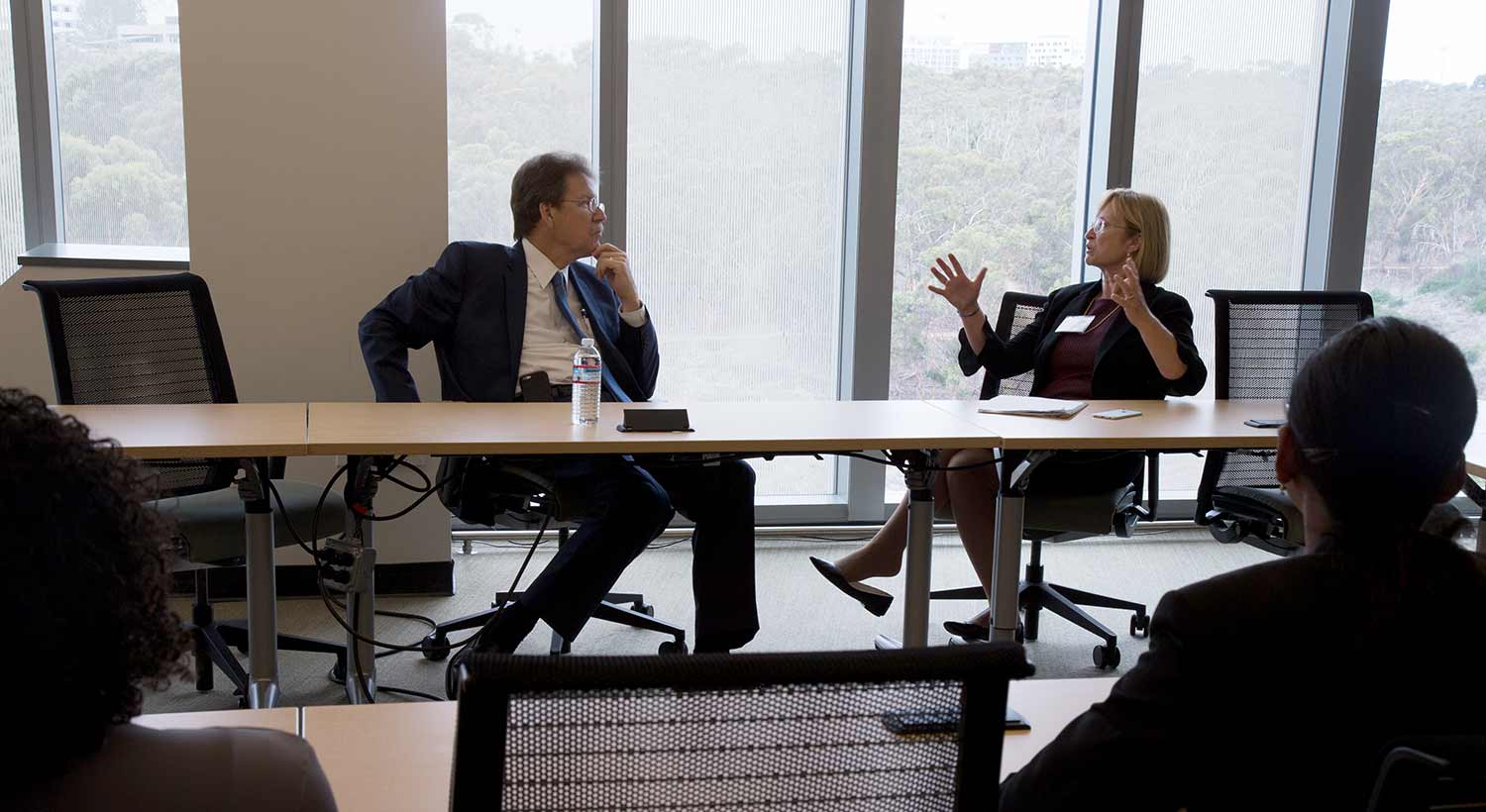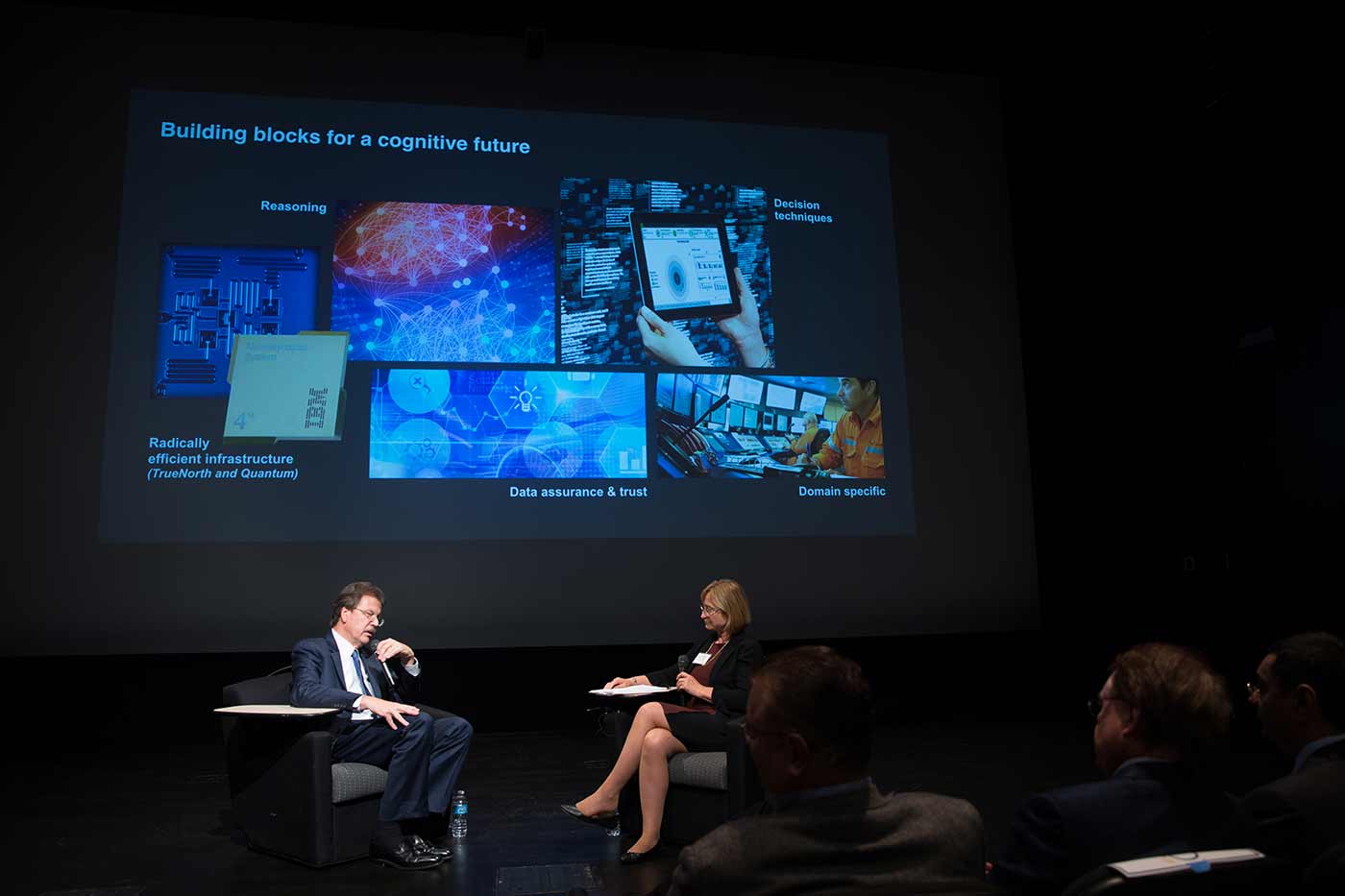
Diverse Research Spectrum on Display as IBM Leaders Visit UC San Diego
Published Date
By:
- Paul K. Mueller
- Emily Bass
Share This:
Article Content

IBM’s John Kelly hears from Vice Chancellor Sandra Brown about avenues of research of interest to his company.
When John Kelly, IBM’s senior vice president for research, and four other IBM leaders visited UC San Diego in mid-October, they were keenly interested in the broad, diverse areas of research well under way on campus.
Vice Chancellor for Research Sandra Brown, Engineering Dean Al Pisano, and Social Sciences Dean Carol Padden made sure the corporate leaders heard – loudly and clearly – that UC San Diego is at the leading edge of research and technologies that hold significant promise for the global industrial giant.
Amidst the high-tech wizardry at Qualcomm Institute's Atkinson Hall, the IBM team received in-depth briefings on contextual robotics, microbiome research, and the “smart cities” collaboration with the city of San Diego.
Vice Chancellor Brown, putting the range of topics in context, emphasized in her introduction that UC San Diego is strongly positioned to lead and partner in large-scale projects – especially those that are integrative in nature, and require a “deep dive” into research areas. The campus is a “living lab,” she said, with many productive relationships with private industry, and an impressive record for creating spinoffs, startups, and other drivers of economic growth.
Of special interest to IBM team members were two distinctions that Brown took care to point out: that UC San Diego, with deep linkages to local schools, admits more community college students than any other UC campus; and that the university has more women graduates in STEM fields than any other U.S. university.
In addition, she reminded her guests, National Geographic picked only one city in North America to designate a “Smart City” – San Diego – due in part to UC San Diego’s role as regional innovator and Torrey Mesa collaborator.
Dean Pisano led the presentation on contextual robotics, stressing the campus’ “encompassing vision” of the technology’s possibilities and promise, and was supported by Dean Padden, who emphasized the key role that cognitive science plays in the field of robotics.

IBM’s Vice President of Research John Kelly and Vice Chancellor for Research Sandra Brown discuss promising areas of current UC San Diego research.
Adding detail to the discussions were computer scientists, social scientists, and engineers, and the subject turned variously to aging, learning, brain development, Big Data, wearable feedback sensors, and the “powerful” entrepreneurial opportunities the university’s multidisciplinary but unified vision can create.
“UC San Diego does a great job of integrating the scientific research done here, and with our healthcare partners, into the community,” Brown said.
When the topic turned to microbiome research, Rob Knight, who leads the Center for Microbiome Innovation on campus, spoke to the value of medical and clinical Big Data and associated insights as the basis for a possible partnership, citing existing partners Illumina and Jansson/Johnson & Johnson.
Larry Smarr, Calit2’s director, cited UC San Diego’s prominent role in Big Data research associated with medicine, and suggested that the university could potentially apply IBM technology to 13 million patients.
“UC San Diego serves as the R&D arm of the city,” said David Graham on the City of San Diego when the visitors and their hosts discussed “Smart Cities,” collaborations among universities and their communities that benefit both.
Cognitive computing, collecting data from sensors, and other technologies were discussed as tools that help communities solve problems – from traffic to changing coastlines to toxins and population fluctuations – and help demonstrate the success of innovative public-private partnerships.
“We’re not only talking about keeping people moving on the highways,” said Brown. “The bigger picture is the region’s quality of life.”
Very smart and focused robots that make industries more efficient; big-data insights into the most perplexing of medical challenges; and universities and cities using research and technology for their mutual benefits – UC San Diego gave the IBM team a concentrated briefing on just some of the inter-related avenues of research now being aggressively explored on campus, and showed that the campus is eager to work with any institution that also values “the bigger picture.”
Share This:
You May Also Like
Stay in the Know
Keep up with all the latest from UC San Diego. Subscribe to the newsletter today.


